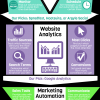High quality photos are an excellent addition to any piece of online content, but what about infographics? An infographic is a combination of visual images and written content and, when done well, can be a significant contribution to your content strategy. The best infographics break down information into bite-sized pieces paired with relevant visuals and graphics. You can use infographics explain your company or brand history, explore product details, and more.
Why Infographics Work
An infographic explains and presents ideas fluidly without making readers switch back and forth between text and images. They capture the reader’s eye and attention and are an entertaining way to receive information. An infographic is appealing to internet users for multiple reasons — they are a quick way to get information and they are easily sharable. While an infographic functions like an image, it contains much more practical information than a photo.
Infographic materials are extremely versatile — you can use them for internal training materials as well as part of your marketing strategy. They are a great way to clear up anything that causes confusion on your website, which helps retain more traffic. An infographic is a flexible way to provide content that is visually appealing and informative, making it a multi-purpose tool that should be part of your marketing arsenal.
Some people may think that infographics are an old-fashioned strategy that won’t work in the digital age. However, infographics provide a valuable opportunity to present deep data and make large amounts of data easily digestible by putting that information into a visual format. 90% of the information the human brain takes in is visual — which is a compelling reason to move away from straight text. Additionally, the average adult reads about 300 words per minute. This seems like a decent amount, but consider that visitors decide whether they will stay on a web page or leave within the first 20 seconds. That only gives them enough time to read about 100 words.
With infographic content, you can capture a reader’s attention and give them the necessary information with fewer words. Infographics allow you to tell big stories efficiently in an easily digestible format.
Using Infographics in Digital Strategy
Calibrating information to best appear on websites has become critical to success into today’s digital environment. More and more companies are focusing on mobile-first strategies — optimizing content for mobile viewing on a smartphone, tablet, or desktop. 70% of today’s Internet use is one on a mobile device and if content is not easily viewable, search engines will rank websites below competitors that are more mobile-friendly.
Infographics are an excellent fit for the web, and are realizing their potential in today’s fast-paced online environment where visual content abounds. As with any piece of online content, it’s important that your images are high quality and calibrated for viewing on all devices. Online viewing has provided myriad opportunities for infographic content that aren’t available for print versions. Mobile viewers can zoom in on parts of infographics and have a more engaging visual experience.
Static Infographics
The most common type of infographic is a static infographic. These render as images, much like a photograph. They typically resize to the screen of a device and the URL and HTML code stay the same, no matter the device. A static infographic usually requires “pinch to zoom” as they are text and image heavy.
Interactive Infographics
Interactive infographics — including animated and video infographics — have emerged over the last few years as mobile technology evolves. There are infographics with special feature when you hover or click on a particular part of the graphic.
Static infographics are still the most prevalent, as they tend to be cheaper and easier to produce, while still getting great engagement results for websites. Whichever type of infographic you use, it’s important to know that infographics are popular.
When you combine graphics and text, content becomes more engaging and more retainable. Infographics are memorable and can often impart data in a more vivid and effective way than visuals or text alone. Infographics are liked and shared 3x more than other types of content on social media..
An interactive infographic can almost serve as mini-website, which makes them a great way to disseminate detailed information that viewers will retain. Choosing between a static or interactive infographic depends on your time and budget, but whichever format you use, start with a skilled designer and prioritize mobile viewing. Outline a text and visual version of your story or product and use an infographic to explain it and bring it to life. If you haven’t already, consider integrating infographic content into your 2017 digital strategy to increase engagement on your website.
Have you made or employed any successful infographics lately? Share your story in the comments below!






